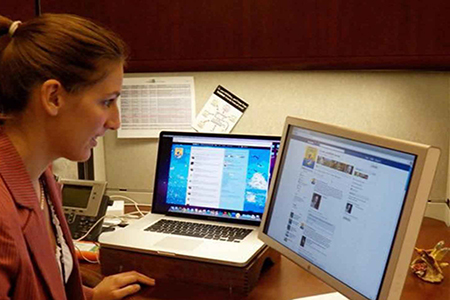THINK ABOUT THIS: 20 years ago college students lugged around clunky typewriters. Now you’d be hard-pressed to find a student who didn’t own a laptop cell phone iPad iPod or other MP3 player. But they aren’t alone; from social media networks to blogs and smartphones colleges are embracing changes in (and using) technology like never before!
From the smartphone that wakes you up in the morning to the iPod that gets your day started or the Web-surfing that ends it you’re always plugged in. Colleges understand that … and they’re plugged in too. The past few years have witnessed some of the biggest technological advances in colleges since the laptop first began to make a widespread appearance on campuses a decade ago.
READ ALL ABOUT IT
The term “blog” was born in 1999 and just over a decade later it seems as if everybody blogs (or at least follows or reads a blog): your mom grandma best friend neighbor—even colleges! Whether written by college admissions staff or actual students college blogs give you a valuable insider’s view on a specific institution. College blogs not only clue you in to what you can expect during your first year at college but ideally they also make you feel a bit more college-ready and confident in the process!
Kathleen Lowe, director of media and marketing services at Roger Williams University (RWU) believes that student blogs are “important because a prospective student can follow that blog for the entire year. So there is ongoing engagement versus the one-time tour or open house session or e-mail.”
There are as many different types of college blogs as there are college students. RWU for example uses student bloggers who represent different aspects of RWU life—study abroad athletics freshman year—with plans to expand. Johns Hopkins University not only has student and admissions bloggers but it also has a separate blog for every offered major and minor so that students can get a glimpse of the kinds of classes and course load that could be in their future.
GET CONNECTED EARLY
You’re always on the Internet anyway so why not do something productive like connect with colleges via social media networks? While nothing can replace the campus visit networking sites can help you get your questions answered! Many colleges’ Twitter and Facebook accounts are headed by admissions counselors and they use these networks as an easy way to remind college hopefuls of new-student events and important deadlines like those for financial aid admissions applications and scholarship opportunities.
This online conversation goes both ways: a large number of colleges actively engage with students on both of these social networks. Kam Stocks, the University of Oklahoma’s Web content video and social media strategist elaborates, “With social media interacting with OU is more personal and the barrier between institution and prospective student is removed by an online community willing to share experiences and answer questions right alongside us. It’s like walking into a room full of friends ready and willing to help!”
Whether college representatives are answering questions or pointing future students to the right college contact Facebook and Twitter are proving to be very worthwhile tools that enable a college to show off a friendlier more accessible side.
More colleges are using the micro-blogging platform Twitter than ever before. Even with 140-character limitations colleges are managing to utilize Twitter in much the same way as Facebook—posting links to college-related materials highlighting current students and aspects of campus life and generally engaging with students academically or not. Some colleges interact with local businesses and “tweet” community events which can help you learn more about the community you will one day call “home” for four years of your life.
With Twitter’s lists function you can easily compare at a glance the current happenings at your favorite colleges and become acquainted with the admissions people behind the Twitter accounts. Twitter usage among the high school crowd is relatively low compared to other age groups so you have a fantastic opportunity to stand out to the college admissions crowd let them put a face (and a personality) to a name and hopefully help increase your odds of getting in.
TWEET YOUR WAY TO AN “A”
These technological changes aren’t just limited to choosing a college. They are spilling over and affecting every aspect of college life including what goes on inside the college classroom. While professors lecture about social networks—how to use them what they mean to society—they’re also beginning to treat them like a classroom necessity as essential as textbooks and No. 2 pencils!
Colleges with a sizable student body like the University of Texas at Dallas are taking advantage of Twitter to connect to students during class providing students with a chance to ask questions in real time and get an immediate response. Other colleges also see the potential. Nicholas Key, creative director at the University of Oklahoma says that the university is “exploring multimedia capture and delivery methods that will empower our faculty to integrate course material and social media.” Large lecture hall or not thanks to Twitter you can still get to know your fellow classmates and professors.
HAVE SMARTPHONE—WILL TRAVEL
Of course it doesn’t end there. Your smartphone and MP3 player go everywhere that you do and colleges know this. Higher education is using iPods and iPhones inside the classroom and out. While you might use these gadgets to record your notes or a lecture many professors also upload class assignments and audio files so that they can spend more time on interactive class discussion instead of hour-long lectures. If you are curious as to what a college lecture will really be like many colleges upload entire course lectures online so anyone can listen in for free. (But no you shouldn’t try to get all four years of your college education by way of your iPhone!)
Colleges also view your cell phone as a simple way to keep you informed about safety alerts or campus updates. And many like Colorado State University offer iPhone application classes that center around creating content for your iPhone. These can range from improving campus life like helping a visitor find a parking space or somewhere to eat to college-department information like faculty and staff bios or contact information.
A slew of colleges and universities have published official iPhone applications designed for use by both students and visitors. For example College of Charleston and the University of North Carolina Wilmington hopefuls can listen to a student-narrated tour complete with campus photos and videos for an in-depth look at the campus from an iPhone or iPod Touch. Rice University students can browse the student newspaper search for a book at the library and check up on athletic scores—all from their smartphone!
GET IN THE ZONE
When it comes to accessing information about the colleges and universities that you are interested in you’ve got plenty of options. Colleges have created virtual tours of the campus and dorm rooms and uploaded YouTube videos; you can browse through campus photos on the photo-sharing website Flickr interact with college admissions offices on social media networking websites like Facebook and Twitter or read about your favorite colleges on their blogs. While these tools can’t replace a campus visit they can be useful supplements and give you a taste of what life at an actual college is like—and may help ease those first-day jitters!
Thanks to colleges integrating the latest and greatest technology you’re no longer just a bystander. You get to take an active role in choosing and preparing for college by using the latest innovations to your advantage! You have years to follow the lives of student bloggers to connect with college admissions representatives on Facebook Twitter and other social networking websites and to take your time thinking about where you really want to spend four years of your life.
Thanks to technological developments narrowing down the college list has never been so easy and you know that when you get there your college of choice will help you stay on top and grow with whatever comes your way. Colleges are “going with the flow” of technology to better prepare you for a busy tech-savvy life ahead!
SIDEBAR
Gadgets 101: 20 Years of Innovation
It’s easier than ever to access information and keep in touch. Your parents didn’t have today’s technological luxuries! Take a look back in time and see how some of your favorite gadgets and gizmos have transformed in the last 20 years—back when My College Guide published its first edition!
CELL PHONES—Mobile phones have come a long way since the first bulky oversized models appeared in the 1980s (along with big hair and metal bands) but these phones really didn’t see much use until the turn of the century about the same time that texting entered the picture. Part of the reason was cost; the first cell phones were about $2,000!
Forget the day-planner address book pen and notepad; when the smartphone hit stores in the early ’00s it changed the way everyone communicated. Jump ahead to the 2007 unveiling of the Apple iPhone (with its down-loadable applications) and mobile phone history was made.
COMPUTERS—Desktop computers firmly took hold in the 1990s and the hum of machinery quietly replaced the clack of the typewriter in dorms and homes—a sound that had been prevalent for over 100 years! Online message boards and chat rooms were the place to be. When laptops entered the scene in the new millennium it became possible to work (or play) on the go.
The Internet started to resemble something a little closer to the present with the introduction of MySpace (2003) and Facebook (2004). Technology changed direction with e-book readers that let users instantly purchase and download e-books seriously gaining in popularity with 2007’s Amazon Kindle. The recent release of the Apple iPad (2010) predicts change yet again but exactly how only time will tell.
MP3 PLAYERS—For music on the go now there’s the slim Apple iPod and other MP3 players but 20 years ago? Unwieldy cassette-tape players (like the Sony Walkman) were your only option. The MP3 player brought in a new song and dance in 1994 allowing people to listen to music in a new way—and download it from the Internet.
New players were introduced throughout the years but it wasn’t until the Apple iPod (2003) and iTunes outlet that audio files could be easily created and uploaded for listening by anyone anywhere.
Jessica Nunemaker is the director of social media for My College Guide.



